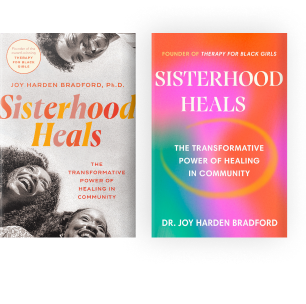When others attempt to get close to you, do you/they avoid or resist the connection? Are you or
someone you know overly guarded or protective of their emotions? Do they show emotions to
an extent…seemingly short, uncomfortable, or changing the topic?
These may be signs of someone who has developed an avoidant attachment style. (There are
more descriptives that can help you identify your attachment style, so it is best to talk through
these signs with a trusted professional). This article will focus on how to identify avoidant
attachment style, its origins in childhood, and how to respond and cope with a special emphasis
on Black women’s lived experiences.
Examples and Signs of Avoidant Attachment:
A person with an avoidant attachment is unfamiliar with emotional intimacy. As a child, they
developed self-soothing techniques to abandon connections that continue into adulthood. They
struggle to be close to others, rejecting before rejecting, even when people desire to be close
to them. Because they cannot express emotions, they may suppress difficult emotions or
cope with them alone. They also may appear to be “perfect,” never having an issue or complaint
even though they are struggling within. Ultimately, they avoid efforts of closeness initiated by
others and contribute to a self-sabotaging cycle. While avoidant attached people avoid
vulnerability, they do have emotional needs and an innate desire to be known.
Where Does Avoidant Attachment Come From?
Referred to as anxious-avoidant or dismissive in previous studies based on the infamous study
by Mary Ainsworth, “The Strange Situation Experiment”. Researchers noted varying responses
of children when reunited with their parents. Regarding the avoidant child, researchers observed
them being wary of strangers, exhibiting great distress when parents leave (or some remaining
calm) but not comforted by the parent when they returned. The child also avoided and resisted
contact with the parent when they returned. What is happening inside of the child- one may
wonder? The child is subconsciously adjusting and learning how to self-soothe to control their emotions to an emotionally unavailable caregiver.
RELATED: Am I Too Traumatized to be in a Relationship?
Whether or not parents are emotionally available, responsive, and in proximity has a lot to do
with developing an attachment style. Can I trust them? Can I rely on them? Those are
questions we subconsciously asked as children and are the questions we ask now to our
partners and friends as adults.
Insecure attachment is developed when emotional needs are neglected and parents are
inconsistent or unavailable emotionally to their children (Diamond, Russon, Levy, 2016). The
parents are often mistuned with the child’s need for emotionality and are avoidant or dismissive.
They also may disapprove or choose not to tolerate any notable display of emotions. They
discourage the outward expression of any emotions such as crying, being noisy, or sensitive.
RELATED: Therapist Help: Tips for Cultivating Emotionally Safe Environments
Black women grow up in diverse living environments that may contribute to the development of
avoidant attachment styles. Some may have had neglectful parents, raised by emotionally
unhealthy caregivers, in and out of foster care systems- the list goes on. From a teen to a young
adult, experiences with romantic partners and friends also contribute to maintaining
these attachment patterns. They may come off as “strong” or as Destiny’s Child will say
“independent” (never needing anyone) and unwilling to allow someone to get too close to them.
As a teen leading into a young adult, experiences with romantic partners (i.e.: infidelity, mentally
ill partners, etc.) and friends, i.e.: (unresolved conflict, experiencing cliques) also contribute to
maintaining these attachment patterns.
Breaking the shame of avoidant and stepping into freedom:
If you’ve identified with this article thus far, resist the urge to develop shame. As Black women,
we already have so many things to undo and unlearn, so this is the part where you praise
yourself for getting this far. You did not develop this attachment style on your own and you are
not your attachment style. Begin to speak positive affirmations and words that point to your
identity.
If you have a friend, partner, parent, or sibling that often rejects your offer of closeness, don’t
take it personally (meaning don’t assume it’s your fault). It’s important to note that sometimes
people are not unwilling but genuinely don’t know how to connect emotionally. They’ve learned
a way to cope that works (to their knowledge). If your relationship is close enough, gently share
your experience but don’t have any expectations of them to change or get it right away. The
person must be willing to work on their own stuff and you might be the first person bringing this
awareness to them. It can take time to accept this.
If you’ve had a series of these conversations, trust the process, and set the necessary boundaries
for yourself. Not all boundaries need to be communicated (eliminate the need to set a
boundary to teach someone a lesson); instead, set an internal boundary that is for your
emotional well-being to avoid self-protection or hurting the relationship. An example may be a
time limit on the conversation or reducing the number of times you bring it up again.
RELATED: Managing Conflict in Friendships and Relationships
People need time and space but, most importantly acknowledgment. Acknowledge that your
past was painful, and/or if you are the perpetrator, acknowledge the harm that was done- even if
you don’t understand or cannot recall specifics. Acknowledging pain goes a long way and is the
pathway to healing.
References:
Ainsworth, M. D. (1985). Patterns of infant-mother attachments: antecedents and effects on
development. Bulletin of the New York Academy of medicine, 61(9), 771.
Diamond, G., Russon, J., & Levy, S. (2016). Attachment‐based family therapy: A review of the









